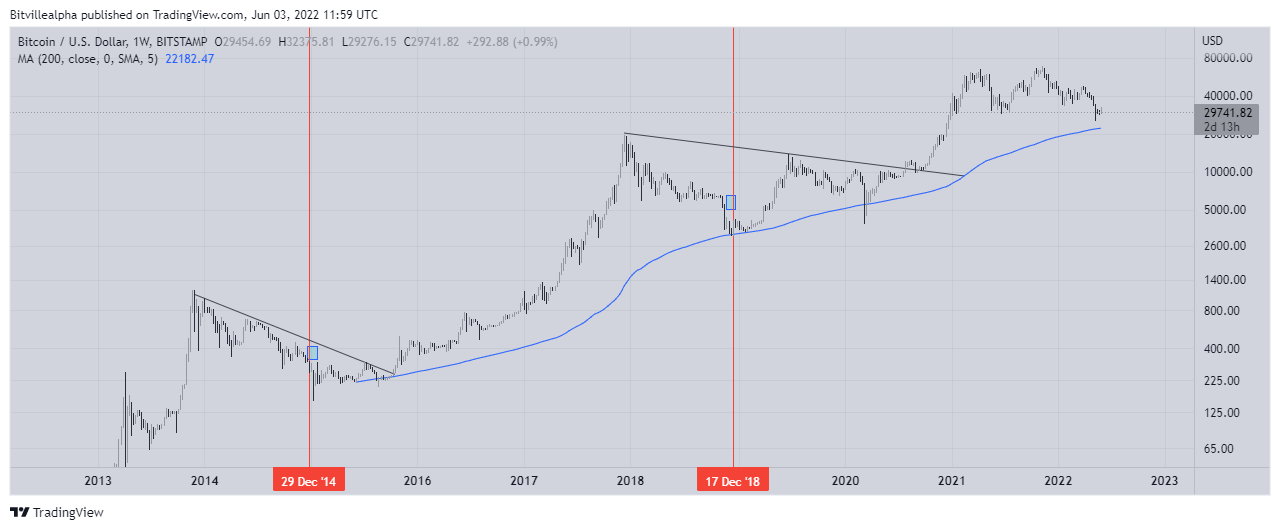BEAR CASE - MARKET PRUNING, ALT PICK CRITERIA
Buying bear market dips are great. But buying the wrong dips?
Bear markets are usually brutal. The current bear market is even more brutal. The bulls were short-lived in comparison to the last cycle. Inflation is getting out of hand. Economic uncertainties escalating even further.
No one knows exactly when the bear market will end, or how long it will last.
Historically, full-blown bear markets usually last a year. However, this does not mean that prices will reach peak highs any soon after that. Bull markets are usually pronounced about a year after Bitcoin halvings. Bitcoin halvings occur every 210,000 blocks - approximately 4 years.
The term “halving” or “halvening” simply means that the number of new bitcoins issued every 10 minutes is cut in half. The last halving in May 2020 reduced the block rewards from 12.5 to 6.5 BTC per block. The next one will reduce it to 3.125 BTC per block.
The estimated date for the next Bitcoin halving is April 1, 2024. This leaves the next bull cycle starting in 2025.
If the next bull cycle is estimated in 2025, how does the bear market supposedly last one year?
There are usually market rallies leading up to the halving. Feel free to call it a pre-halving rally. Bitcoin and altcoin prices have historically bottomed out at/slightly below the 200 weekly moving average, followed by a market rally in between that usually succumbs to a diagonal trend line resistance from the previous top. See chart below.
Depending on when price tests the 200 weekly moving average, a potential diagonal trendline from the $69,000 top could see Bitcoin struggle to breach $30,000 - $34,000 region.
These, however, are nothing but permutations regardless of how accurate whatever data backing them might seem. The first job you have is to protect yourself.
Make decisions based on the possibility of the market not recovering any sooner.
The market needs pruning
I discreetly witnessed the 2018 bear market. One thing that is guaranteed is that not all altcoins will get back to their all-time highs.
A couple of factors might be responsible for this, ranging from projects being nothing but a fork and no improvement on an original idea, the birth of new narratives, teams abandoning their projects/ rugging, teams running out of treasury funding and/or being unable to raise VC funds and keep the ball rolling in a bear season.
Never assume all projects are prepared to build in the bear. Some of the project founders are very young and might even be experiencing their first cycle, hence, didn’t see the need to prepare for rainy days. The bears are good for weeding out unserious projects - there are way too many anyway.
It’s a tough decision DCA-ing into a project that isn’t building behind the scenes or stands very little chance of recovery in the next run.
Most retail players don’t care about tech in the bull. Everyone is just chasing shiny stuff - where the money goes the fastest.
On the flip side, there are projects that will recover, break their all-time highs and dive into price discovery. We saw this in the last bull run with projects like ETH, BNB, ADA, etc.
On making bear decisions
It’s tough to decide on what’s best to pick in a bear season. However, a few metrics should guide your decisions.
Do your research on projects that have survived multiple cycles, those that have so far established market dominance and some form of monopoly, projects that have judiciously followed their roadmap, and are transparent enough to show proof of sufficient funding to deliver on their vision, bull or bear.
Look out for projects that are generating real revenue, not from dumb token emissions that only lead to inflation and a downward spiral in price.
One tool I use to analyze revenue is token terminal, and more specifically the Price to earnings (P/E) ratio metric.
It’s time to honestly scan through your portfolio. Let go of what you have confirmed does not meet some of these criteria above. Prune and re-allocate.
No harm in a little shuffle for the greater good.
This information above is in no way an endorsement to buy/ sell any particular cryptocurrency, but only for educational purposes to guide your decision-making.






